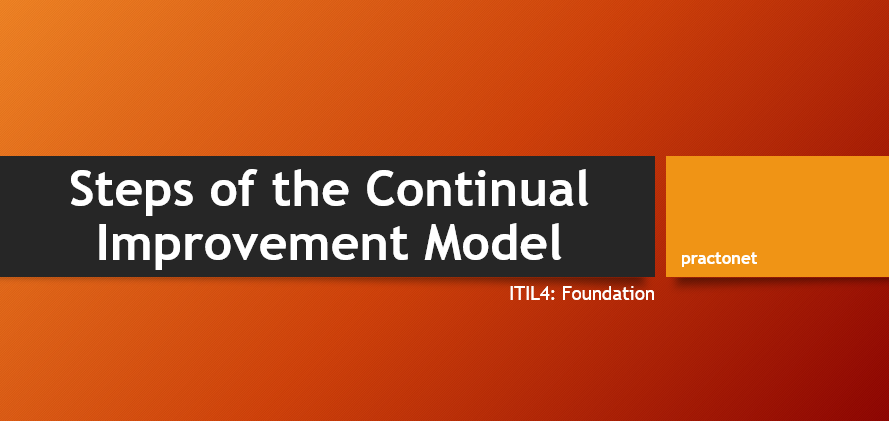This section provides more detail on each step of the continual improvement model. An organization can adjust these steps to its culture and goals. The model is simple and flexible, and can just as easily be used in an Agile culture as in a more traditional waterfall culture.
Step 1: What is the vision?
Each improvement initiative should support the organization’s goals and objectives. The first step of the continual improvement model is to define the vision of the initiative. This provides context for all subsequent decisions and links individual actions to the organization’s vision for the future.
This step focuses on two key areas:
- The organization’s vision and objectives need to be translated for the specific business unit, department, team, and/or individual, so that the context, objectives, and boundaries for any improvement initiative are understood.
- A high-level vision for the planned improvement needs to be created.
The work within this step should ensure that:
- The high-level direction has been understood
- The planned improvement initiative is described and understood in that context
- The stakeholders and their roles have been understood
- The expected value to be realized is understood and agreed
- The role of the person or team responsible for carrying out the improvement is clear in relation to achieving the organization’s vision.
If this step is skipped, improvements might only be optimized for the people or teams involved rather than the whole organization, or non-value-adding activities might become the sole focus of improvements.
Step 2: Where are we now?
A key element in this step is a current state assessment. This is an assessment of existing services, including the users’ perception of value received, people’s competencies and skills, the processes and procedures involved, and/or the capabilities of the available technological solutions. The organization’s culture, i.e. the prevailing values and attitudes across all stakeholder groups, also needs to be understood to decide what level of organizational change management is required.
Current state assessments should be done through objective measurement whenever possible. This will allow for an accurate understanding of the issues associated with the current state and, once the initiative is implemented, enable proper measurement of the level of improvement achieved by comparison with the initial state. If a good measurement system is in place, the information to fulfil this step may already have been provided when the proposed improvement was initially documented. If this step is skipped, the current state will not be understood and there will not be an objective baseline measurement. It will therefore be difficult to track and measure the effectiveness of the improvement activities, as the new state cannot be compared with a previous state at a later point.
The success of an improvement initiative depends on a clear and accurate understanding of the starting point and the impact of the initiative. An improvement can be thought of as a journey from Point A to Point B, and this step clearly defines what Point A looks like. A journey cannot be mapped out if the starting point is not known.
Step 3: Where do we want to be?
Based on the results of the first two steps, a gap analysis can be performed, which evaluates the scope and nature of the distance to be travelled from the starting point to the achievement of the initiative’s vision. It is important to note that the initial vision of the initiative is aspirational and may never be achieved in full. Improvement is the goal, not perfection. This step should define one or more prioritized actions along the way to completing the vision for the improvement, based on what is known at the starting point. Improvement opportunities can be identified and prioritized based on the gap analysis, and improvement objectives can be set, along with critical success factors (CSFs) and key performance indicators (KPIs).
The agreed objectives, CSFs, and KPIs need to follow what is known as the SMART principle. They should be specific, measurable, achievable, relevant, and time-bound. It is much easier to define the route of the improvement journey if the exact destination is known. It is important to note that the target state represents progress towards the vision, not the achievement of the entire vision. If this step is skipped, the target state will remain unclear. It will be difficult to prepare a satisfactory explanation of what key stakeholders stand to gain from the improvement initiative, which may result in low support or even pushback.
Step 4: How do we get there?
Now that the start and end points of the improvement journey have been defined, a specific route can be agreed. Based on the understanding of the vision of the improvement and the current and target states, and combining that knowledge with subject matter expertise, a plan for addressing the challenges of the initiative can be created.
The plan for Step 4 can be a straightforward and direct route to completing a single simple improvement, or it may be more involved. The most effective approach to executing the improvement may not be clear, and it will sometimes be necessary to design experiments that will test which options have the most potential. Even if the path to follow is clear, it may be most effective to carry out the work in a series of iterations, each of which will move the improvement forward part of the way. With each iteration, there is an opportunity to check progress, re-evaluate the approach, and change direction if appropriate.
If this step is skipped, the execution of the improvement is likely to flounder and fail to achieve what is required of it. Failed improvements erode confidence and can make it difficult to get support for future improvements.
Step 5: Take action
Some improvements take place as part of a big initiative that makes a lot of change, whereas other improvements are small but significant. In some cases, a larger change is effected through the implementation of multiple smaller improvement iterations. Even if the path to complete the improvement seemed clear when it was planned, it is important to remain open to change throughout the approach. Achieving the desired results is the objective, not rigid adherence to one view of how to proceed.
During the improvement, there needs to be continual focus on measuring progress towards the vision and managing risks, as well as ensuring visibility and overall awareness of the initiative. ITIL practices such as organizational change management, measurement and reporting, risk management and, of course, continual improvement are important factors in achieving success in this step. Once this step is completed, the work will be at the end point of the journey, resulting in a new current state.
Step 6: Did we get there?
This step involves checking the destination of the journey to be sure that the desired point has been reached.
Too often, once an improvement plan is set in motion, it is assumed that the expected benefits have been achieved, and that attention can be redirected to the next initiative. In reality, the path to improvement is filled with various obstacles, so success must be validated.
For each iteration of the improvement initiative, both the progress (have the original objectives been achieved?) and the value (are those objectives still relevant?) need to be checked and confirmed. If the desired result has not been achieved, additional actions to complete the work are selected and undertaken, commonly resulting in a new iteration. If this step is skipped, it is hard to be sure whether the desired or promised outcomes were actually achieved, and any lessons from this iteration, which would support a course correction if needed, will be lost.
Step 7: How do we keep the momentum going?
If the improvement has delivered the expected value, the focus of the initiative should shift to marketing these successes and reinforcing any new methods introduced. This is to ensure that the progress made will not be lost and to build support and momentum for the next improvements.
The organizational change management and knowledge management practices should be used to embed the changes in the organization and ensure that the improvements and changed behaviors are not at risk of reversion. Leaders and managers should help their teams to truly integrate new work methods into their daily work and institutionalize new behaviors.
If the expected results of the improvement were not achieved, stakeholders need to be informed of the reasons for the failure of the initiative. This requires a thorough analysis of the improvement, documenting and communicating the lessons learned. This should include a description of what can be done differently in the next iteration, based on the experience gathered. Transparency is important for future efforts, regardless of the results of the current iteration. If this step is skipped, then it is likely that improvements will remain isolated and independent initiatives, and any progress made may be lost over time. It may also be difficult to get support for future improvements, and embed continual improvement in the organization’s culture.





